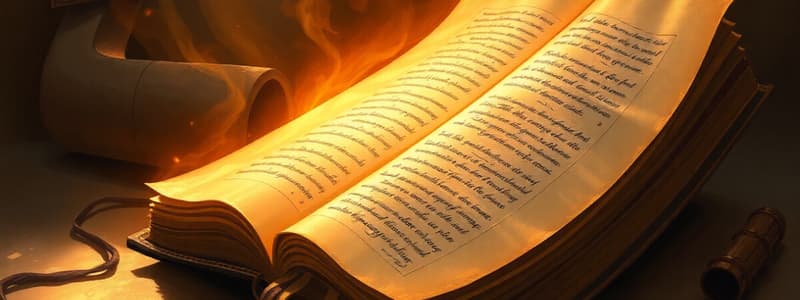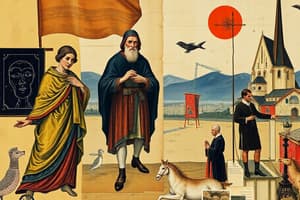Podcast
Questions and Answers
What is the significance of the Ryland's Papyrus in relation to the New Testament?
What is the significance of the Ryland's Papyrus in relation to the New Testament?
- It is a fragment dating close to the time of the original writing. (correct)
- It contains writings from several authors of the Old Testament.
- It was discovered more than 400 years after the original documents.
- It is a complete manuscript of the New Testament.
How many total books make up the Bible?
How many total books make up the Bible?
- 66 (correct)
- 39
- 27
- 50
Which two individuals are noted as the only Gentile writers in Scripture?
Which two individuals are noted as the only Gentile writers in Scripture?
- Timothy and Titus
- Job and Isaiah
- Matthew and Mark
- Nebuchadnezzar and Luke (correct)
What was the time span over which the Bible was written?
What was the time span over which the Bible was written?
What is the estimated number of Greek manuscripts of the New Testament?
What is the estimated number of Greek manuscripts of the New Testament?
Which ancient document has the second highest number of manuscripts after the Bible?
Which ancient document has the second highest number of manuscripts after the Bible?
Why is the time gap between original documents and manuscripts important?
Why is the time gap between original documents and manuscripts important?
What is a key factor that establishes the Bible's authenticity historically?
What is a key factor that establishes the Bible's authenticity historically?
Flashcards
Bible's Time Span & Authors
Bible's Time Span & Authors
The Bible was written over a long period, from about 1445 BC to 95 AD, by more than 40 authors.
Bible's Structure
Bible's Structure
The Bible is composed of 66 books divided into two sections: 39 books in the Old Testament and 27 in the New Testament.
Gentile Author of the New Testament
Gentile Author of the New Testament
Luke, a Gentile, wrote a significant portion of the New Testament.
Bible's Manuscript Copies
Bible's Manuscript Copies
Signup and view all the flashcards
Bible's Manuscript Dating
Bible's Manuscript Dating
Signup and view all the flashcards
Ryland's Papyrus
Ryland's Papyrus
Signup and view all the flashcards
Bible's Historical Authenticity
Bible's Historical Authenticity
Signup and view all the flashcards
Manuscript Count Comparison
Manuscript Count Comparison
Signup and view all the flashcards
Study Notes
Bible Manuscript Authenticity
- Bible's history spans over 1500 years, from Moses (1445 B.C.) to the New Testament's final book (95 A.D.)
- Composed of 66 books (39 Old Testament, 27 New Testament) authored by 40 distinct individuals.
- Two Gentile authors exist: Luke (significant contributor to the New Testament) and a writer only noted for a chapter, Nebuchadnezzar.
- Over 25,000 manuscripts containing parts of the New Testament are available.
- 5,700 are Greek manuscripts.
- Early translations exist in Latin, Coptic, Syriac, etc.
- Quotations from early church fathers provide additional evidence.
- The completeness of the New Testament could be pieced together from early church father quotations alone.
- The Bible possesses more manuscript copies than any other ancient document.
- The second most numerous ancient manuscript collection is the Iliad, with 643 documents.
- Biblical manuscripts are significantly closer in time to the originals than any other ancient document.
- The Iliad's earliest copy was written 400 years after the original;
- The Ryland's Papyrus (a John's Gospel fragment) dates within 25-30 years of its original writing.
- Complete books of the New Testament were available within a century of their composition.
Studying That Suits You
Use AI to generate personalized quizzes and flashcards to suit your learning preferences.



